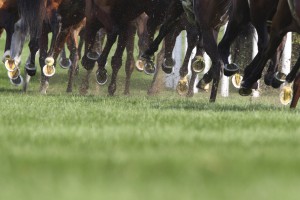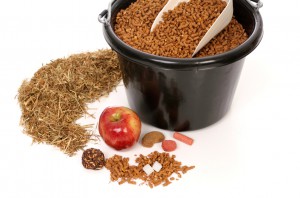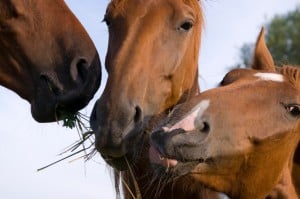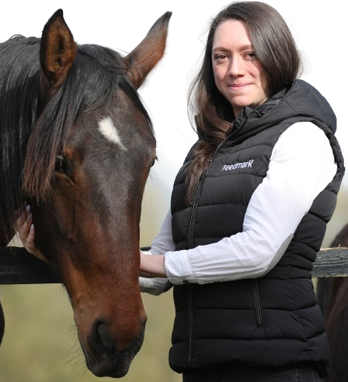What are Gastric Ulcers? The horse’s stomach is divided into two sections: a non-glandular ‘squamous region’ and a glandular region. These are separated by a fibrous divide known as the Margo Plicatus. The glandular section is protected by a thick mucus layer, containing glands which secrete active enzymes called pepsins, gastric acids that aid digestion by breaking down food, and bicarbonates and mucus, which protect the stomach lining. The non-glandular section has very little protection from the gastric acid, apart from the buffering action of saliva and certain foods. Gastric Ulcers (also known as Equine Gastric Ulcer Syndrome or EGUS) occur when there is an imbalance between protective buffering factors and the aggressive gastric acids within the stomach. EGUS affects both parts of the stomach, but due to lack of protection ulcers are more likely to be found in the non-glandular region, with 80% of ulcers found here (Nadeau & Andrews, 2009). The term EGUS covers all levels and severities of ulcer, from thickening of the stomach lining to lesions and deeper ulceration.  All equines are at risk of gastric ulcers. Recent studies have shown that up to 90% of racehorses, 67% of competition horses and 58% of show horses display some level of ulceration, probably due to inadequate nutrition and management. Just weaned foals are predisposed to this condition due to thin, easily eroded mucosal lining, affecting almost 50%. EGUS is also not uncommon in adult pleasure riding horses. If you think that your horse may be suffering from ulcers, call your veterinary surgeon. They may diagnose the problem through clinical signs displayed by your horse or by using an endoscope to view the stomach lining. Horses suffering from gastric ulceration will usually display some or all of the following typical symptoms: colic, abdominal pain (usually shown through a dislike of being girthed, groomed, the rider applying leg aids or being touched on their sides), a poor appetite, weight loss, and a rough and dull coat. These issues will in turn often result in poor performance, and grumpy, antisocial behaviour. Why do horses get gastric ulcers? There are many factors which may contribute to or increase the risk of gastric ulcers.
All equines are at risk of gastric ulcers. Recent studies have shown that up to 90% of racehorses, 67% of competition horses and 58% of show horses display some level of ulceration, probably due to inadequate nutrition and management. Just weaned foals are predisposed to this condition due to thin, easily eroded mucosal lining, affecting almost 50%. EGUS is also not uncommon in adult pleasure riding horses. If you think that your horse may be suffering from ulcers, call your veterinary surgeon. They may diagnose the problem through clinical signs displayed by your horse or by using an endoscope to view the stomach lining. Horses suffering from gastric ulceration will usually display some or all of the following typical symptoms: colic, abdominal pain (usually shown through a dislike of being girthed, groomed, the rider applying leg aids or being touched on their sides), a poor appetite, weight loss, and a rough and dull coat. These issues will in turn often result in poor performance, and grumpy, antisocial behaviour. Why do horses get gastric ulcers? There are many factors which may contribute to or increase the risk of gastric ulcers.  A common culprit is feeding large amounts of starchy feeds, such as high carbohydrate mixes, cubes and straights. This is particularly common in competition horses and those with heavy workloads. Feeding diets high in starch means the horse has to chew less than if fed the equivalent amount of forage. This has a couple of effects; the horse’s stomach is full for less time, so acid levels rise. Less chewing means less buffering saliva is produced. At the same time, more acid is produced from the higher levels of carbohydrate fermentation. This means that the stomach has less buffering, alkaline materials in it, less food bulk and fibre to help protect the delicate lining, and becomes more acidic. In fact, An average horse fed over 1 kg of concentrate feed per day (only one Stubbs scoop of a mix!) have been shown to have ulcers twice as severe as those on forage diets. Similarly, feeding a diet low in forage is also a risk factor for ulcer development, all forages have a buffering action, and produce higher levels of saliva. In addition to this, certain forages such as alfalfa are high in calcium, a natural antacid! Unlike humans, horses stomachs continuously produce stomach acid, and ideally horses should be given forage adlib, or at the last every 5 hours to reduce risk of ulceration. If this doesn’t happen, which commonly occurs when people are trying to make horses lose weight, no buffering food or saliva is present to counter the acid production. In addition to this, if a horse is exercised on an empty stomach, the acid is more likely to splash around, harming the non-glandular region. As well as the nutritional causes, stressed and anxious horses are also more likely to develop ulceration, as stress inhibits the production of bicarbonate secretions in the stomach. Excessive use of NSAID drugs will also compromise the stomach mucosa, as will Devil’s Claw. How to reduce risk of ulcers, and manage those who have been diagnosed With any medical or behavioural issue, prevention is better than cure, and ensuring that horses are given the correct diet, stresses and medication with side effects are controlled.
A common culprit is feeding large amounts of starchy feeds, such as high carbohydrate mixes, cubes and straights. This is particularly common in competition horses and those with heavy workloads. Feeding diets high in starch means the horse has to chew less than if fed the equivalent amount of forage. This has a couple of effects; the horse’s stomach is full for less time, so acid levels rise. Less chewing means less buffering saliva is produced. At the same time, more acid is produced from the higher levels of carbohydrate fermentation. This means that the stomach has less buffering, alkaline materials in it, less food bulk and fibre to help protect the delicate lining, and becomes more acidic. In fact, An average horse fed over 1 kg of concentrate feed per day (only one Stubbs scoop of a mix!) have been shown to have ulcers twice as severe as those on forage diets. Similarly, feeding a diet low in forage is also a risk factor for ulcer development, all forages have a buffering action, and produce higher levels of saliva. In addition to this, certain forages such as alfalfa are high in calcium, a natural antacid! Unlike humans, horses stomachs continuously produce stomach acid, and ideally horses should be given forage adlib, or at the last every 5 hours to reduce risk of ulceration. If this doesn’t happen, which commonly occurs when people are trying to make horses lose weight, no buffering food or saliva is present to counter the acid production. In addition to this, if a horse is exercised on an empty stomach, the acid is more likely to splash around, harming the non-glandular region. As well as the nutritional causes, stressed and anxious horses are also more likely to develop ulceration, as stress inhibits the production of bicarbonate secretions in the stomach. Excessive use of NSAID drugs will also compromise the stomach mucosa, as will Devil’s Claw. How to reduce risk of ulcers, and manage those who have been diagnosed With any medical or behavioural issue, prevention is better than cure, and ensuring that horses are given the correct diet, stresses and medication with side effects are controlled.  Giving your horse sufficient access to forage is an easy way to reduce risk of ulceration- horses need at least 1.5% of their bodyweight in forage per day, which should be split and fed at least every 5 hours, if ad-lib forage is not an option. If your horse hasn't eaten for a few hours, it is advisable to feed a scoop of chaff prior to exercise. If possible, feed an all forage diet, and if additional calories are needed oil is a great addition. However, if your horse needs concentrates due to their work, split into as many feeds per day as possible, and mix generously with chaff. Alfalfa and Unmolassed sugar beet are particularly useful feeds for horses prone to ulceration, as they are both high fibre also high in calcium, which acts as an antacid. In addition to this, feeding a supplement aimed at helping to keep the stomach environment healthy is often beneficial. Oliva Colton MSc -Nutritional and Technical Coordinator For more information about EGUS, or if you have any other nutritional questions please call 0800 585525 to speak to a nutritional advisor, or go to www.feedmark.com
Giving your horse sufficient access to forage is an easy way to reduce risk of ulceration- horses need at least 1.5% of their bodyweight in forage per day, which should be split and fed at least every 5 hours, if ad-lib forage is not an option. If your horse hasn't eaten for a few hours, it is advisable to feed a scoop of chaff prior to exercise. If possible, feed an all forage diet, and if additional calories are needed oil is a great addition. However, if your horse needs concentrates due to their work, split into as many feeds per day as possible, and mix generously with chaff. Alfalfa and Unmolassed sugar beet are particularly useful feeds for horses prone to ulceration, as they are both high fibre also high in calcium, which acts as an antacid. In addition to this, feeding a supplement aimed at helping to keep the stomach environment healthy is often beneficial. Oliva Colton MSc -Nutritional and Technical Coordinator For more information about EGUS, or if you have any other nutritional questions please call 0800 585525 to speak to a nutritional advisor, or go to www.feedmark.com
Equine Gastric Ulcer Syndrome
26 Mar 2015
